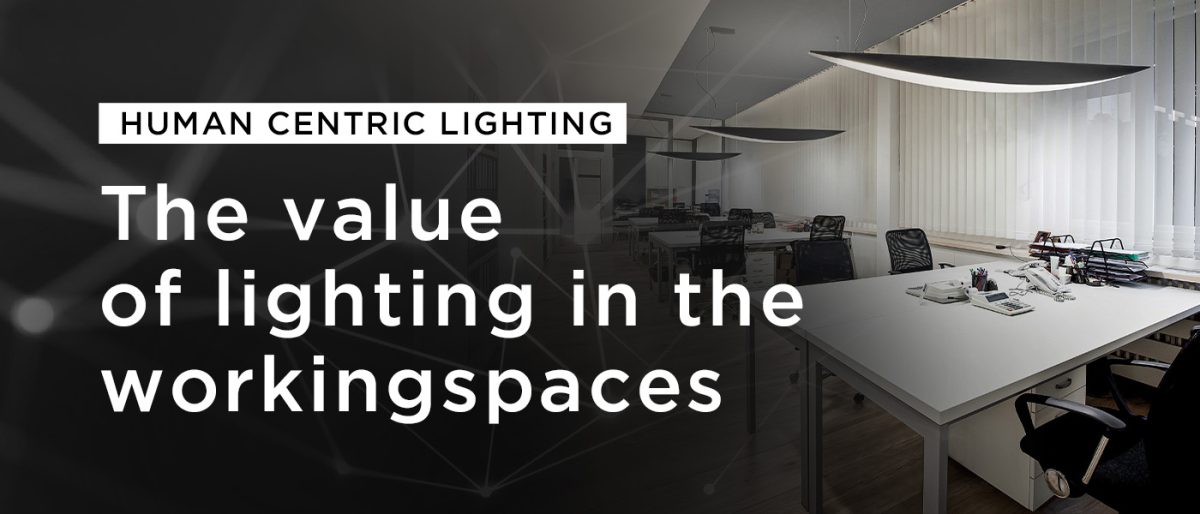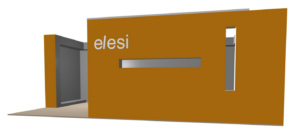The new frontier of the lighting sector has a specific name – Human Centric Lighting – and specific areas of application, such as school and aged care homes.
“Office lighting” topic is also well represented among the human centric designing subjects: the working spaces represent those places where a human being spends most of her/his time and therefore they deserve to be studied.

Humans and nature
Nature has always marked our biological rhythms through the sunlight exposure or not. Within 24 hours, the light-dark cycle sets the pace, giving time to our body for a well-defined cycle of activity and rest that has cadenced the human life from the beginning.
So, the day-night cycle is a key factor that controls the hormone release, the sleeping and waking
patterns, along with the blood pressure.
The blue light
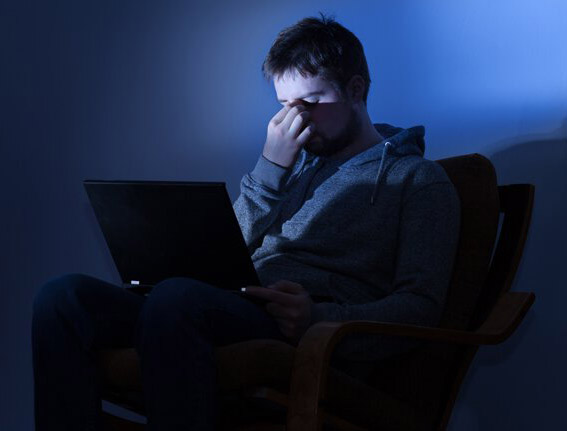
It has particularly been shown that a light colour can make a difference: a lighting stimulus of specific blue frequencies at night signals to our brain that it is still daylight, inhibiting the melatonin production and making harder to sleep. Therefore, the exposure to this light in the evening is potentially harmful for our health because it desynchronizes our biological clock at the base of life on Earth (the circadian rhythms). During daylight hours, the correct usage of the same light can provide positive effects on people’s performances instead.
MOOD and MEMORY
It has always been quite clear that light has effects on mood too: just think about the long winter days, when the lack of light brings bad mood, irritability and energy lack, especially during the delicate transition from a season to another.

The chronobiologist Samer Hattar from John Hopkins University has carried out a study recently where he has shown that light activates particular eyes cells (intrinsically photosensitive retinal ganglion cells or IPRGC) that, in turn, transmit signals to the brain centres in charge of our mood, learning and memory. That is thus light to regulate the behaviours related to mood and cognitive functions.
The advent of the electric lighting enabled people to carry out daytime activities after sunset, introducing night work or on shifts. Anyway, that change has brought other consequences: in fact, flipping days for nights can lead to depression, along with memory issues. It is noteworthy that the results of the experimentation show the onset of learning problems just after finding mood disorders.
The chronobiologist’s research highlights that the major cause of those alterations is not much
about the lack of sleep, but they are due to the exposure to the bright light of the light sources.
LIGHT THERAPY
Therefore, it is no coincidence that light is increasingly being used as a real therapy: Michael
Terman the author of Chronotherapy, has highlighted that the change of light during the various
phases of the year or the change of lighting inside the buildings can affect the human behaviour.
The research carried out shows that 53,3% of people with seasonal affective disorder (SAD) have
benefited from a significant improvement of depressive symptoms by the light therapy (Light
Therapy).
So, the blue light is not only harmful: if it used at the right time of the day, it can be a real ally to
ensure an individual’s well-being.
HUMAN CENTRIC LIGHTING IN THE WORLD
TOKYO
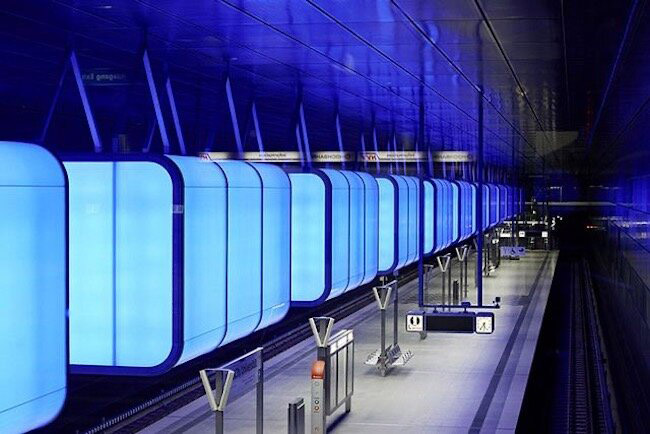
In Tokyo, blue lights have been installed in the subway and at the railway stations of the city in order to hinder the high suicide rate.
The outcome has been amazing: the introduction of these installations has reduced the deaths by 84%.
MOSCOW
In Moscow, the latest generation subway has given prominence to lighting too. Trains equipped with
LED lights adapting to the time of the day: a cooler light during the daytime that gradually becomes
warmer as the evening advances.
The system, coherent with the basic principles of human centric lighting, enables the commuters to
reach high levels of vigilance and productivity. The night lighting, lower on the Kelvin scale, fosters
the melatonin production for a quality sleep, instead.

Flexible spaces and a dynamic light
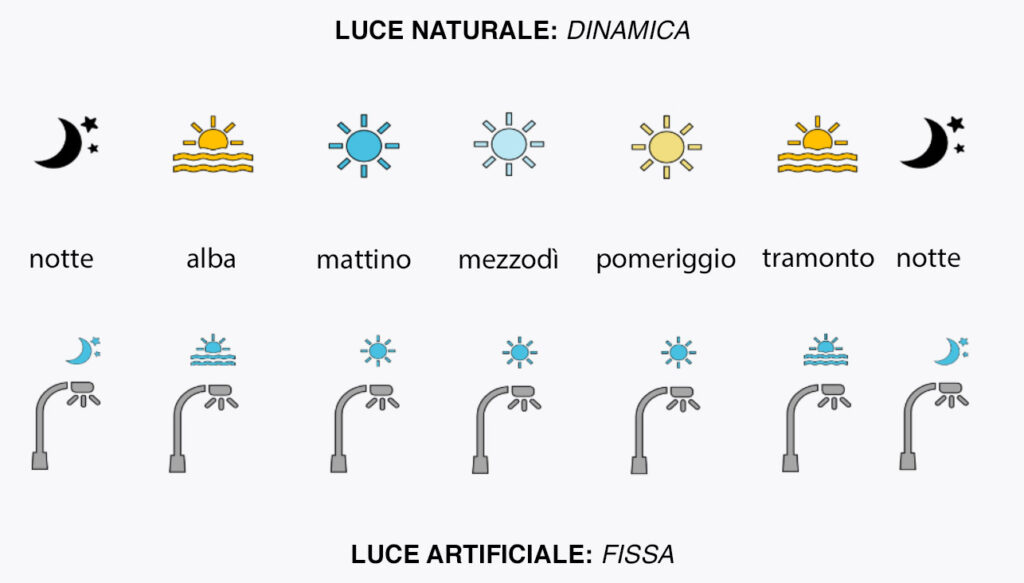
Times change and, along with them, the traditional office work too. Pandemic has speeded up the transformation, making office activities increasingly more dynamic and flexible. Working models are changing and, along with them, their spaces: the static workstations, where each place was assigned in a strict and inflexible way, have been becoming a thing of the past. The fragmentation in place is going to give rise to real work areas.
Therefore, offices are changing into a multifunctional environment, where we can make room for interaction and human connection, along with production: technology and architecture have to help to provide answers to the new worker’s needs.
A resilient design
In an increasingly evolving work world, lighting design has to be able to adapt to change.
Human Centric Lighting solutions are combined in a holistic way to ensure the emotional, biological and visual effects of light.
The lighting impact affects a variety of factors:
- activity, ensuring an excellent visual comfort
- architecture, by an enhancement of the spaces
- atmosphere, by proper hierarchies of perception
- worker’s well-being and thereby a performance increase

THE LEGISLATION
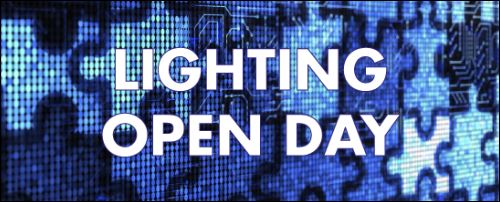
The European standard UNI EN 12464-1 2021 – currently in force introduced the non-visual effects of light, finally giving due consideration to this topic of growing interest.
The new standard refers to the visual aspects of lighting, but it also includes the non-visual ones: it particularly deals with how lighting influences the circadian rhythms and mood, as well as it can
improve people’s performances.
Daniele Lizzani, a member of GL2 UNI, spoke about that in a interview with Lighting Open Day in 2019: “Another very important criterion that was included in the standard and, for the first time in a standard, even if just on the information level, is the concept of “human centric lighting”, so putting people at the centre of needs, therefore of the benefits that light – or at least some types of light – can provide people. In that case, we have several quantities of natural light and, at the same time, also those ones provided by the artificial light inside the analysed space”.
The studies and the outcomes in workplaces
The research is increasing on how the dynamic light can fulfil people’s phycological and chronobiological needs in a particular time of the day and performing specific activities. The outcomes strongly suggest the adoption of light systems in accordance with the principles of human centric lighting.
Healthy Offices
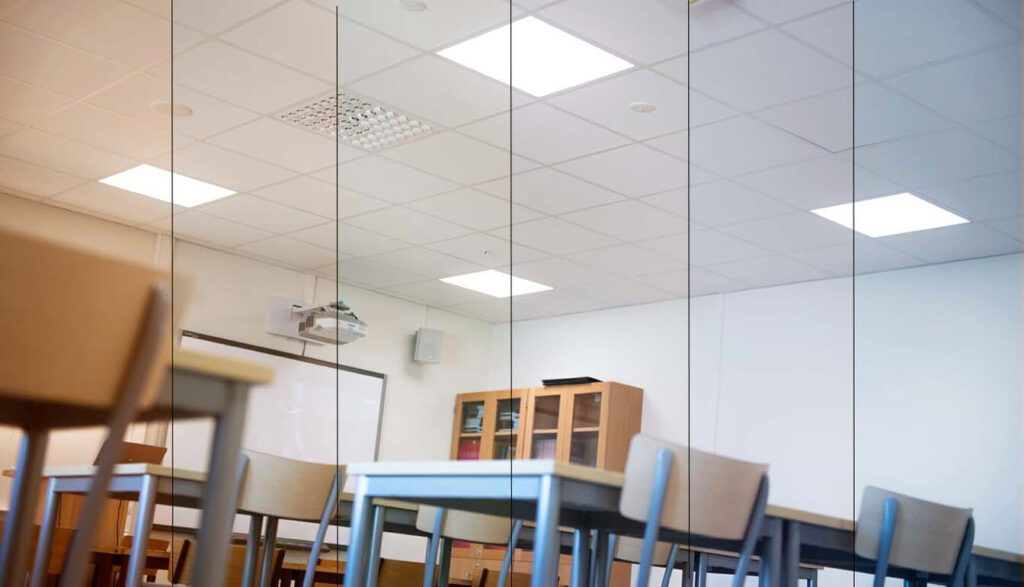
We particularly want to focus on a study called “Healthy Offices”, carried out in partnership with Twente University, The Free University Amsterdam and the real estate consultant CBRE Holland, where they highlighted the quality of indoor space for people’s well-being and performance.
They installed a “human centric lighting” solution inside CBRE’s headquarters in Amsterdam: that installation included a time-controlled lighting system with a sequence of lights following the circadian rhythms.
The test
They intensified the light intensity up to almost double the normal by an indirect light from hanging fixtures and by high levels of vertical illuminance. The latter, along with the cold white light from the indirect component, acted on workers during the morning hours and the early afternoon. A warmer and softer light stimulated the employees in the middle of the day and towards the evening, instead. The measurements lasted for a total of seven months.
THE FINDINGS
The new set-up, including the human centric lighting, gave the expected results.
- the work performance improved of 18%
- 71% of workers experienced more energy
- 76% had a beneficial impact on their mood
- 50% found health improvements
- 12% an increase in accuracy.
Those amazing findings are a tangible proof that the investments in human centric lighting can give
back big figures: healthier offices to decrease sickness expenses and employees’ turnover, maximizing
production at the same time.
Targeted surveys
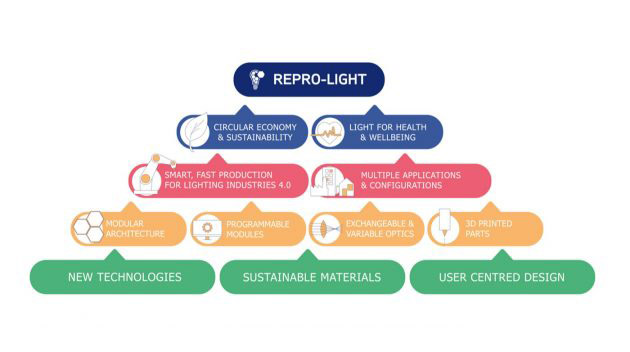
Repro-Light is a European Commission founded project for the development of a modular and
tailored lighting, as well as respectful of the circular flow economy. The main focus of the research,
where they involved Italy too, is the attention paid to people; in this sense, they carried out targeted
surveys where they highlighted the light effects:
- Over 90% of respondents think the lighting of their workplace can affect their mood
- 87% say that it affects their performance
- 92% think it influences the vigilance at work
The survey shows that gender and age influence the individual’s needs: the women and the
workers over 50 feel the need for better lighting.
“Light can positively influence the individual’s skill to remain vigilant and to maintain high cognitive
performance. Moreover, the lighting systems around us during the day can affect our sleep”,
explains Wilfried Pohl, leader of the research team.
The light aspects for a human centric design
The different conditions of the natural lighting during the day govern our biological clock; the same
light can have negative effects or positive ones depending on the time of exposure.
Time and the setting of the colour temperature (tunable white) play an important role in lighting
design, but we cannot consider them the only elements able to affect the non-visual light effects.
The human centric design focuses on several aspects of light, all equally important:
- time
- brightness
- light spectrum
- light distribution
Bespoke design
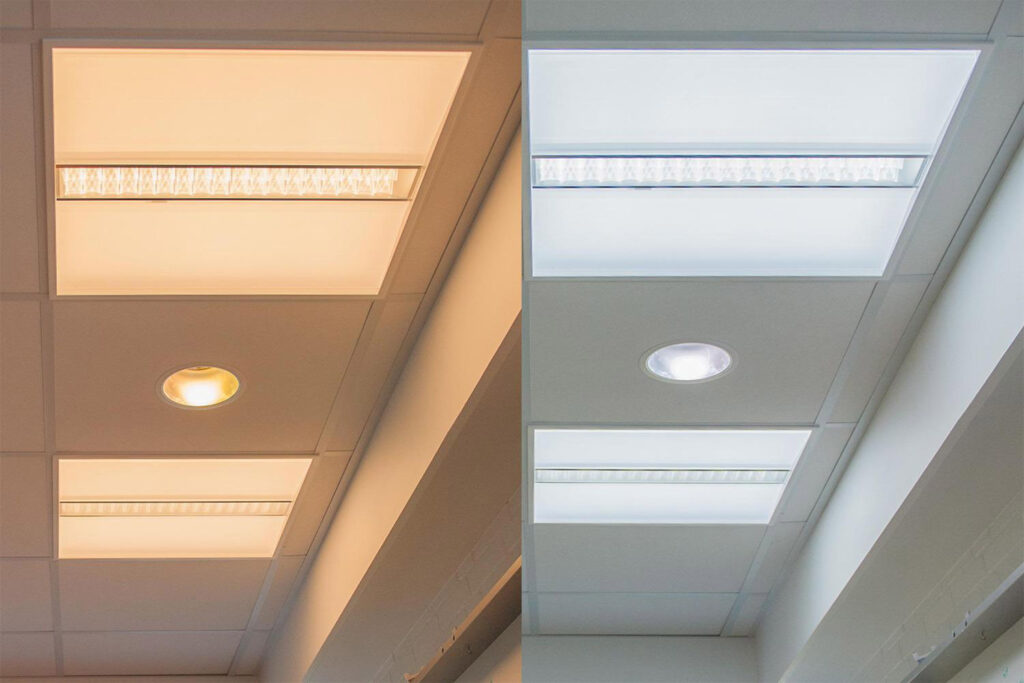
In the past, the lighting design of the working spaces only focused on the kind of activity to be performed. Nowadays, the information we have shows us the new way to go: dynamic and customized light.
Human Centric Lighting means placing the individual at the centre of design, since each individual is unique and with needs that can vary depending on gender and age. Therefore, there is not one solution able to uniquely satisfy any context: however, we have all necessary information to concretely develop a design plan compliant with human centric lighting.
The joint use of lighting fixtures with light control devices can provide a biologically strong light with optimum support for occupants’ health and performance. All what above without forgetting vital aspects such as visibility, dazzling or flicker.
The value of lighting
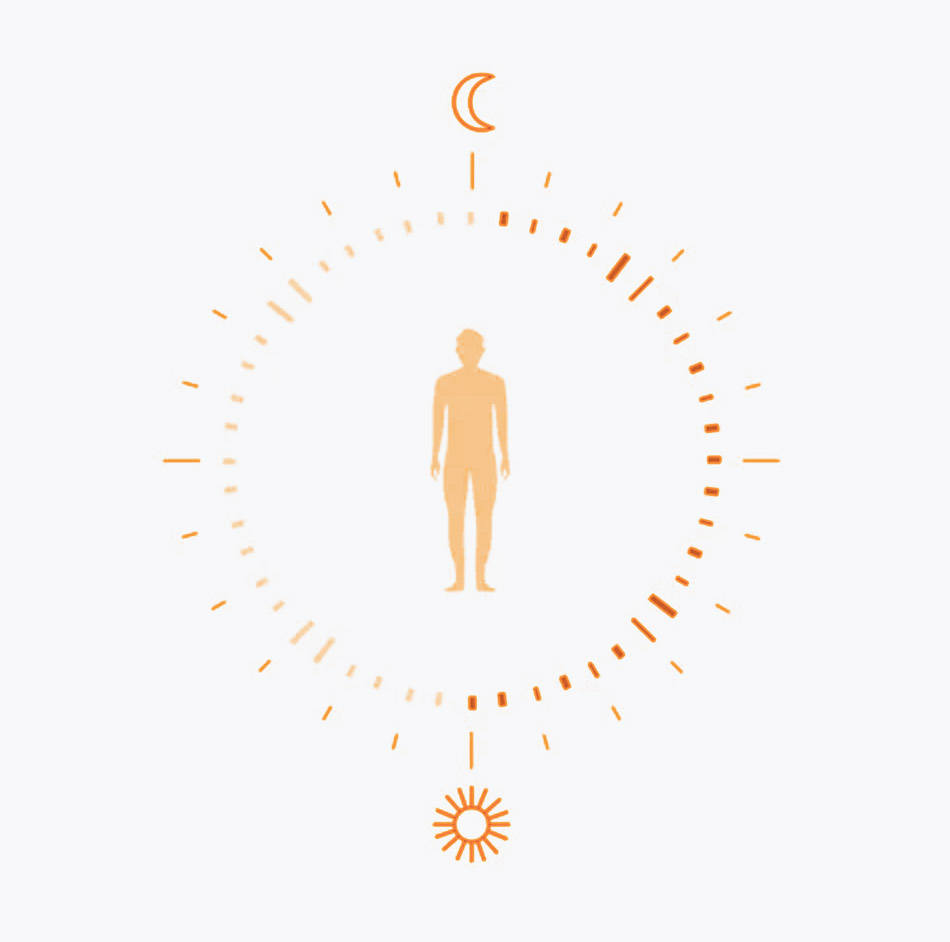
Elesi Luce actively supports the culture of light and it consistently engages in the dissemination of human centric principles. A proper exposure to light is essential for the regulation of the circadian rhythms and to ensure health and well-being to our body. In work environment, lighting particularly affects the performance aspects, such as memory and concentration, essential features in any professional sector. Therefore, the company commits to bringing the culture of light where there is a need, for instance promoting specialized courses for its customers/distributors.
Elesi believes in teamwork, especially in the dissemination of such a sensitive and still little known issue. Its participation to Luce in Veneto confirms the collaborative spirit characterizing the company. The business network, to which the governance of Venezia Smart Lighting – the Regional Innovative Network – has been entrusted, has set the dissemination of the culture of light among its specific goals.
In the Sustainable Living field, we speak about the well-being in living environment provided by the manufacturing of lamps with spectral output respecting the circadian rhythms.
The new Human Centric Lighting paradigms have been included among the new project areas of interest, as well as among the main market trends.
To be ready for change
The lighting industry has been experiencing a deep change in the recent years: the symbiotic development of the technological evolution and sustainability.
The principles of sustainability on which the new lighting is based aim to reduce energy consumption as well as facing the light impact on people’s well-being and health.
The Internet of Things and the new information at Light disposal enable to adapt lighting to users’ needs.
Elesi Luce is participating to the change and it is doing its best so that the value of light will be the main character in the future of the lighting sector: the lighting solutions will have to provide an appropriate light quantity and an appropriate spectrum according to activities, at the right time of day and for a proper period of time.




